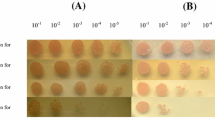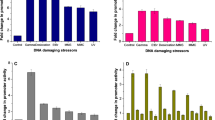Abstract
Deinococcus radiodurans was considered as one of the most radiation-resistant organisms on Earth because of its strong resistance to the damaging factors of both DNA and protein, including ionizing radiation, ultraviolet radiation, oxidants, and desiccation. PprM, as a bacterial cold shock protein homolog, was involved in the radiation resistance and oxidative stress response of D. radiodurans, but its potential mechanisms are poorly expounded. In this study, we found that PprM was highly conserved with the RNA-binding domain in Deinococcus genus through performing phylogenic analysis. Moreover, the paper presents the analysis on the tolerance of environmental stresses both in the wild-type and the pprM/pprM RBD mutant strains, demonstrating that pprM and RNA-binding domain disruptant strain were with higher sensitivity than the wild-type strain to cold stress, mitomycin C, UV radiation, and hydrogen peroxide. In the following step, the recombinant PprM was purified, with the finding that PprM was bound to the 5’-untranslated region of its own mRNA by gel mobility shift assay in vitro. With all these findings taken into consideration, it was suggested that PprM act as a cold shock protein and its RNA-binding domain may be involved in reaction to the extreme environmental stress in D. radiodurans.




Similar content being viewed by others
References
Slade D, Radman M (2011) Oxidative stress resistance in Deinococcus radiodurans. Microbiol Mol Biol Rev 75:133–191. doi:10.1128/MMBR.00015-10
Cox MM, Battista JR (2005) Deinococcus radiodurans—the consummate survivor. Nat Rev Microbiol 3:882–892. doi:10.1038/nrmicro1264
Ishino Y, Narumi I (2015) DNA repair in hyperthermophilic and hyperradioresistant microorganisms. Curr Opin Microbiol 25:103–112. doi:10.1016/j.mib.2015.05.010
Tsai CH, Liao R, Chou B, Contreras LM (2015) Transcriptional analysis of Deinococcus radiodurans reveals novel small RNAs that are differentially expressed under ionizing radiation. Appl Environ Microbiol 81:1754–1764. doi:10.1128/AEM.03709-14
Lange CC, Wackett LP, Minton KW, Daly MJ (1998) Engineering a recombinant Deinococcus radiodurans for organopollutant degradation in radioactive mixed waste environments. Nat Biotechnol 16:929–933. doi:10.1038/nbt1098-929
Makarova KS, Aravind L, Wolf YI, Tatusov RL, Minton KW, Koonin EV, Daly MJ (2001) Genome of the extremely radiation-resistant bacterium Deinococcus radiodurans viewed from the perspective of comparative genomics. Microbiol Mol Biol Rev 65:44–79. doi:10.1128/MMBR.65.1.44-79.2001
Munteanu A-C, Uivarosi V, Andries A (2015) Recent progress in understanding the molecular mechanisms of radioresistance in Deinococcus bacteria. Extremophiles 19:707–719. doi:10.1007/s00792-015-0759-9
Frenkiel-Krispin D, Minsky A (2006) Nucleoid organization and the maintenance of DNA integrity in E. coli, B. subtilis and D. radiodurans. J Struct Biol 156:311–319. doi:10.1016/j.jsb.2006.05.014
Hua Y, Narumi I, Gao G, Tian B, Satoh K, Kitayama S, Shen B (2003) PprI: a general switch responsible for extreme radioresistance of Deinococcus radiodurans. Biochem Biophys Res Commun 306:354–360. doi:10.1016/s0006-291x(03)00965-3
Lu H, Gao G, Xu G, Fan L, Yin L, Shen B, Hua Y (2009) Deinococcus radiodurans PprI switches on DNA damage response and cellular survival networks after radiation damage. Mol Cell Proteomics 8:481–494. doi:10.1074/mcp.M800123-MCP200
Ohba H, Satoh K, Sghaier H, Yanagisawa T, Narumi I (2009) Identification of PprM: a modulator of the PprI-dependent DNA damage response in Deinococcus radiodurans. Extremophiles 13:471–479. doi:10.1007/s00792-009-0232-8
Jeong SW, Seo HS, Kim MK, Choi JI, Lim HM, Lim S (2016) PprM is necessary for up-regulation of katE1, encoding the major catalase of Deinococcus radiodurans, under unstressed culture conditions. J Microbiol 54:426–431. doi:10.1007/s12275-016-6175-8
Airo A, Chan SL, Martinez Z, Platt MO, Trent JD (2004) Heat shock and cold shock in Deinococcus radiodurans. Cell Biochem Biophys 40:277–288. doi:10.1385/CBB:40:3:277
Pelicic V, Reyrat JM, Gicquel B (1996) Expression of the Bacillus subtilis sacB gene confers sucrose sensitivity on mycobacteria. J Bacteriol 178:1197–1199
Schafer A, Tauch A, Jager W, Kalinowski J, Thierbach G, Puhler A (1994) Small mobilizable multi-purpose cloning vectors derived from the Escherichia coli plasmids pK18 and pK19: selection of defined deletions in the chromosome of Corynebacterium glutamicum. Gene 145:69–73
Adachi M, Hirayama H, Shimizu R, Satoh K, Narumi I, Kuroki R (2014) Interaction of double-stranded DNA with polymerized PprA protein from Deinococcus radiodurans. Protein Sci 23:1349–1358. doi:10.1002/pro.2519
Tamura K, Peterson D, Peterson N, Stecher G, Nei M, Kumar S (2011) MEGA5: molecular evolutionary genetics analysis using maximum likelihood, evolutionary distance, and maximum parsimony methods. Mol Biol Evol 28:2731–2739. doi:10.1093/molbev/msr121
Hall BG (2013) Building phylogenetic trees from molecular data with MEGA. Mol Biol Evol 30:1229–1235. doi:10.1093/molbev/mst012
Mojib N, Andersen DT, Bej AK (2011) Structure and function of a cold shock domain fold protein, CspD, in Janthinobacterium sp. Ant5-2 from East Antarctica. FEMS Microbiol Lett 319:106–114. doi:10.1111/j.1574-6968.2011.02269.x
White O, Eisen JA, Heidelberg JF, Hickey EK, Peterson JD, Dodson RJ, Haft DH, Gwinn ML, Nelson WC, Richardson DL, Moffat KS, Qin H, Jiang L, Pamphile W, Crosby M, Shen M, Vamathevan JJ, Lam P, McDonald L, Utterback T, Zalewski C, Makarova KS, Aravind L, Daly MJ, Minton KW, Fleischmann RD, Ketchum KA, Nelson KE, Salzberg S, Smith HO, Venter JC, Fraser CM (1999) Genome sequence of the radioresistant bacterium Deinococcus radiodurans R1. Science 286:1571–1577. doi:10.1126/science.286.5444.1571
Mitta M, Fang L, Inouye M (1997) Deletion analysis of cspA of Escherichia coli: requirement of the AT-rich UP element for cspA transcription and the downstream box in the coding region for its cold shock induction. Mol Microbiol 26:321–335
Devigne A, Mersaoui S, Bouthier-de-la-Tour C, Sommer S, Servant P (2013) The PprA protein is required for accurate cell division of γ-irradiated Deinococcus radiodurans bacteria. DNA Repair (Amst) 12:265–272. doi:10.1016/j.dnarep.2013.01.004
Acknowledgements
This work was supported by funding from the National Natural Science Foundation of China (Grant No. 81272993).
Author information
Authors and Affiliations
Corresponding author
Ethics declarations
Conflicts of interest
All authors declare no conflicts of interest.
Electronic Supplementary Material
Below is the link to the electronic supplementary material.
Rights and permissions
About this article
Cite this article
Li, W., Ma, Y., Yang, J. et al. RNA-Binding Domain is Necessary for PprM Function in Response to the Extreme Environmental Stress in Deinococcus radiodurans . Indian J Microbiol 57, 492–498 (2017). https://doi.org/10.1007/s12088-017-0684-y
Received:
Accepted:
Published:
Issue Date:
DOI: https://doi.org/10.1007/s12088-017-0684-y




